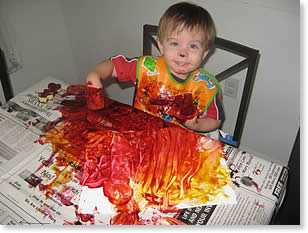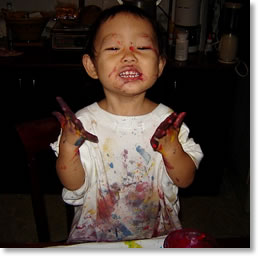Art With Toddlers and Twos? Face the Fear!
by MaryAnn F. Kohl
Copyright © 2015 Bright Ring Publishing, All rights reserved.
For questions or permissions to reprint, write to us here.
![]()
 Are you imagining paint and glue everywhere but on the paper? No wonder! Toddlers and twos are exuberant and messy, but face the fear! It’s going to be easier than you thought. And more fun too. By doing art with your toddler, you will be giving him or her more learning and growth benefits than you can imagine, including the all-important development of fine motor skills, and the wonder of exploration and discovery that builds independent creative individuals.
Are you imagining paint and glue everywhere but on the paper? No wonder! Toddlers and twos are exuberant and messy, but face the fear! It’s going to be easier than you thought. And more fun too. By doing art with your toddler, you will be giving him or her more learning and growth benefits than you can imagine, including the all-important development of fine motor skills, and the wonder of exploration and discovery that builds independent creative individuals.
Toddlers Are Like Snowflakes
Toddlers (little ones, ages one through three) are unique in the kingdom of child development. They are emerging as a separate self from Mommy and Daddy and are beginning to become independent and, therefore, more challenging in their outright declarations of “By myself!” or “No, no, no.” This is truly a rigorous time for both adult and toddler. Because toddlers are going through many changes of independence and separation, they often are uncertain or resistant during this time. Support and encouragement are keys to making this transition time a happy one.
 Does this scenario sound familiar? One day, your toddler vehemently resists an activity, and the next day, the same activity is welcomed openly and with enthusiasm. Toddlers offer adults a, shall we say, unique challenge in flexibility and patience.
Does this scenario sound familiar? One day, your toddler vehemently resists an activity, and the next day, the same activity is welcomed openly and with enthusiasm. Toddlers offer adults a, shall we say, unique challenge in flexibility and patience.
See how your toddler compares to common characteristics of toddlerhood. It should be reassuring to see your own toddler described in many of the following statements:
- seeks new and interesting stimuli
- has a strong sense of “mine” and is learning “not mine”
- likes predictable routines, but can adjust
- is willing to experiment with art materials
- likes something one day and not the next and then likes it again
- is perfecting fine motor skills
- is often fearful of strangers, but can adjust
- usually is somewhat anxious about separation from parents
Every toddler has a unique personality and a unique level and pace of development. Like snowflakes, no two toddlers are alike, and no two toddlers achieve the same skill levels at the same time or in the same exact way. Temperament traits along with developmental pace must be taken into account if expectations of toddlers and their art experiences are to be successful and enjoyable.
Toddler temperament can be across the board: some toddlers are sensitive, while others seem impervious to distress; some throw tantrums, while others are flexible; and of course, most are somewhere on the continuum of points in between. Feisty, fearful, adaptable, shy, docile, cautious, positive, negative, moody, intense, distracted, and active are all traits that apply to one toddler or another, sometimes to the same toddler all in one day! Let your special toddler’s temperament help you predict which art activities will work best on any given day. If it won’t work today, try it tomorrow! Being flexible, supportive, and nurturing is the key to working with toddlers. So, take a deep breath and jump in!
![]()
“It’s the Process, Not the Product”
Toddlers explore art as a learning experience, an experiment, and an activity of discovery that is simulating and interesting. They are more interested in the process of doing art than the resulting finished product. There is no such thing as a cookie cutter perfect craft for toddlers – it’s simply of no interest to them. During the process, toddlers discover their own independent creativity, as well as mystery, joy, delight, and frustration – important pieces in the puzzle of learning. Whatever the resulting artwork – a bright sticky glob or a gallery-worthy masterpiece – to a toddler, it is only the result of “doing art”, not the reason.
The art process allows toddlers to explore, discover, and manipulate their worlds. Sometimes the process can be sensory, such as feeling slippery cool paint on bare fingers. Other times it is mysterious as colors blend unexpectedly, or a blob of playdough takes form. Art process can be a way to “get the wiggles out” or to smash a ball of clay instead of another toddler.
Exploring the process of art will give the toddler wide experiences and time to learn and develop both naturally and appropriately. The adult’s marvelous job is simply to allow it to happen. Provide interesting materials. Sit back and watch closely but unobtrusively. Offer help with unruly materials and clean-up, but don’t make art samples for toddlers to copy, as this will limit the possibilities of process and hinder the wonder of discovery.
To communicate to the toddler that the process is indeed as important as they believe, you can try to use insightfully open-ended comments that will encourage your toddler to feel free to explore but not curtail creativity. Some possible comments are:
- Tell me about your artwork (painting, drawing, playdough, etc.)
- Did you like doing this? Did you like making this?
- Show me the fluffy part
- I see you’ve used many colors!
- How does the paint feel?
- Look at the bright yellow!
- What a big design!
- I see you’ve made your own brown.
- What are you going to try next?
8 Helpful Tips for Happy Clean (relatively) First Art Experiences
1. Cover the workspace – whether is it a table, floor, chair, wall, or countertop – with newspaper. Tape it down to prevent wiggles and spills. It’s much easier to bunch up sheets of painty, sticky newspaper and find a clean space underneath than to clean up uncovered workspaces time and again. Other recommended alternative workspace coverings are flat sheets of cardboard, an old shower curtain, a plastic or vinyl tablecloth, wide butcher paper, or roll ends of newsprint from the local newspaper print shop.
2. Make clean-up with toddlers easy and independent and all the less worry for the adult in charge! Place a wet sponge, a wet folded old towel, or pads of damp paper towels next to the art project for toddlers to wipe fingers as needed. A bucket of soapy water near the work table substitutes for a sink across the room.
3. The ultimate successful cover-up suggestion for toddlers is to wear art clothes that are worn for art only. Toddlers and adults can then enjoy art activities completely worry-free about clothing stains and spills. Art clothes might consist of a slip on T-shirt, easy pull-on pants, and old Velcro-style sneakers, all of which are quick to put on and take off.
4. Toddlers usually work most comfortably painting either standing or kneeling. If sitting, their feet should touch the floor to give them better balance and comfort.
5. Consider protecting a larger circle of space around the workspace for stray splatters, like floors, walls, and carpets.
6. It’s never too late to start collecting recyclables for art. Save collage materials, fabric and paper scraps, Styrofoam grocery trays, yarn, sewing trims, junk mail, sticks and pebbles. Use heavy plastic storage bags, shoe boxes, or any containers on hand for storage.
7. Once or one is never enough for most toddlers! Repeat activities over and over, and allow toddlers to make one or many art projects. Have plenty of paper and supplies on hand for multiple art experiences. The more they create, the more they learn.
8. Safety with toddlers should be of prime concern at all times. Never leave a toddler unattended. All toddler art activities require attentive supervision and care. If working with smaller objects for collage or sorting, always sit one-on-one with the toddler to supervise closely. Be especially cognizant of objects that are small enough to be swallowed, pointy objects that may poke, and remember to use only art supplies that are labeled non-toxic.
(Because toddlers like to test objects with their lips and tongues, use a choke tube to assess which items small enough to choke on. A small parts “tester” or choke tube is available at hardware stores and better toy stores for approximately one dollar. Items particularly attractive to toddlers but extremely risky include balloons, pennies, marbles, staples, tacks, and paperclips.)
Toddler’s Creed
The Toddler’s Creed appeared in the syndicated weekly newspaper article “Families Today” by T. Berry Brazelton and is a humorous reminder of normal toddler behavior:
If I want it, it’s mine.
If I give it to you and change my mind later, it’s mine.
If I can take it away from you, it’s mine.
If I had it a little while ago, it’s mine.
If it’s mine, it will never belong to anybody else, no matter what.
If we are building something together, all the pieces are mine.
If it looks just like mine, it is mine.
reprinted with permission
And when they’re all grown up…
Though it is hard to believe, one day these little dynamos will be all grown up and toddler days will be long gone. Along the way, save your toddler’s artworks and photographs of your precious one at work in this easy to make keepsake book idea. One of the greatest joys of being a young adult is seeing that someone cared enough to hold the past dearly in a scrapbook or box. This easy suggestion will give you a focus for saving memories.
Copyright © 2014 MaryAnn F. Kohl All Rights Reserved.
